- Your cart is empty
- Continue shopping

This post may contain affiliate links. We may receive a small commission, at no cost to you, if you make a purchase. Read Disclosure.
There are many historic cities in England, but none retain their history quite like Bath, the UK’s most iconic Roman town. Here, the Romans didn’t leave quietly – they left their steaming thermal waters, sure, but left their relaxation ethos behind.
Today, Bath is known for its honey-hued Georgian terraces, Jane Austen heritage sites, rooftop spas, cobblestone crescents and cozy coffee shops where the scones are as big as your head.
As one of the UK’s few cities that’s dubbed a UNESCO World Heritage Site, and a double-inscribed site, you can bet there are plenty of things to do in Bath to keep you occupied.
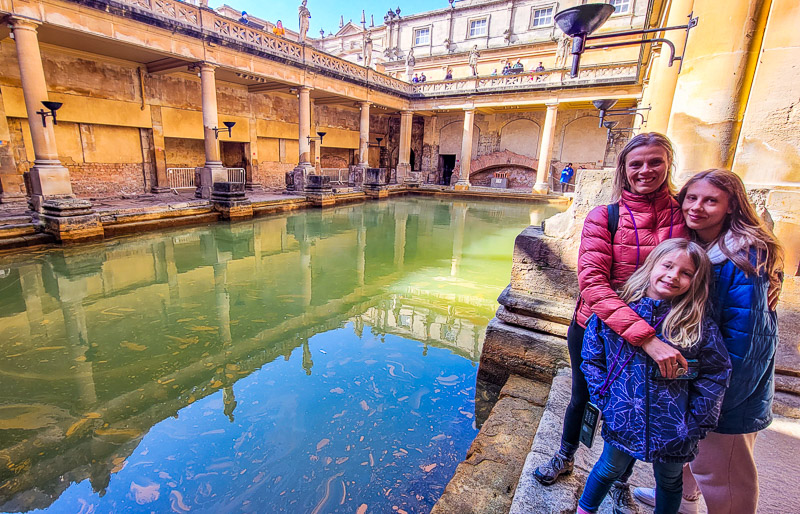
Whether you’re on the hunt for afternoon tea rooms, looking to explore fascinating Roman Baths, or the architecture of the Bath Abbey and Pulteney Bridge, you’ll never run out of attractions in Bath to keep you busy for a weekend.
We visited Bath during our two-week trip to London, which is only 80 minutes way by train. We knew there were so many things to see in Bath that we had to make it an overnight stop. Here’s what we loved…
1. Take a guided walking tour of Bath
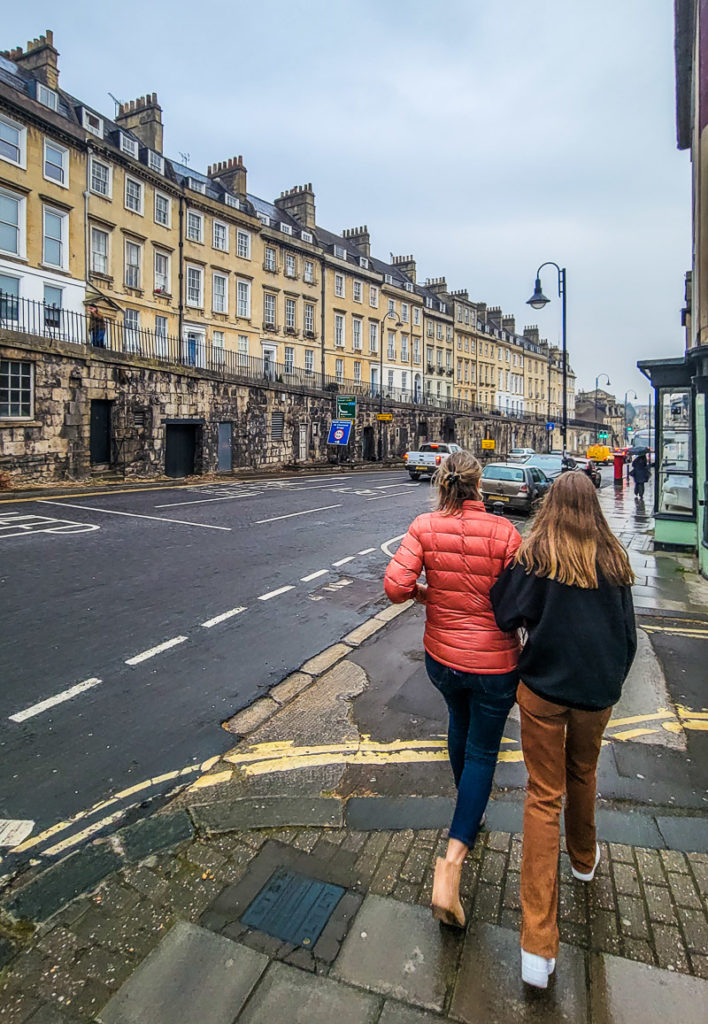
A good way to start your trip to Bath is with a guided walking tour. This will give you a fantastic overview of the city, including the history of Bath, some of the characters who’ve lived here, what modern bath is like, and an insight into what to do there. Then you’ll know what to return to and experience on a deeper level throughout your stay in Bath.

Our tour guide was friendly, and knowledgeable, and made an effort to include our kids in the discussions. She had a bag of artifacts she’d pull out to help tell the story when she could.
She pointed out places where popular movies or TV have been filmed, like Bridgerton, or Bath Street where the new Willy Wonka was filmed only weeks before we visited. You heard it here first.

We began the tour at the Bath Abbey and Roman Baths where we learned its history beginning from the Romans through to the Medieval and Georgian times.
From there we walked up through the more modern Bath (hundreds of years old modern) where we learned more about the architectural story of Bath and its glamorous residential areas of the Circus and Royal Crescent, and the Assembly Rooms (which were closed).
Had we done this tour first thing, I would have returned to see the inside of the Assembly Rooms (the glamor settings of the Bridgerton Balls!).
2. Check out the Ancient Roman Baths
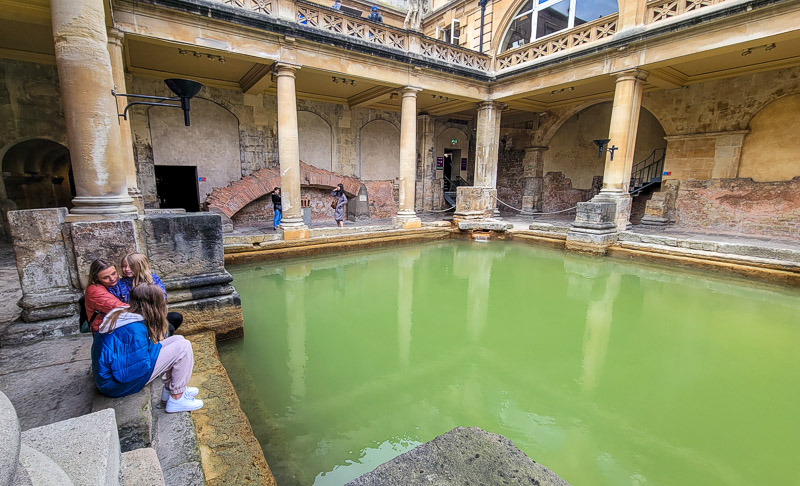
The most well-known attraction in Bath is the 2,000-year-old Roman Baths, the place of Britain’s only natural thermal waters. It stands in the center of the city and is one of the best-preserved Roman remains in the world and the most important north of the Alps. Back then, the beautiful city the Romans built around the baths was called Aquae Sulis.
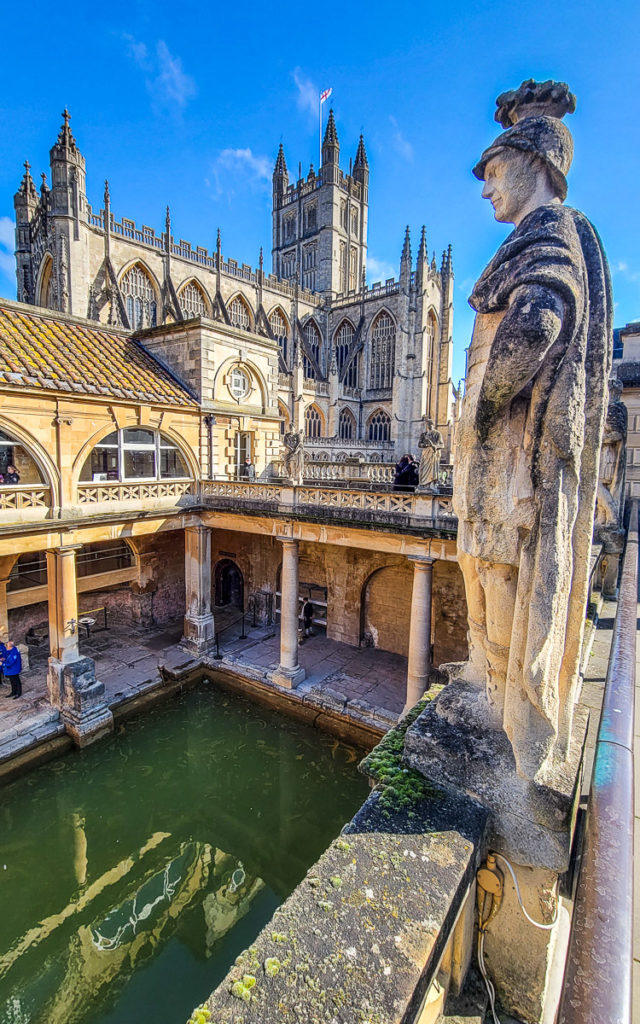

A visit to the Roman Baths will give you a great sense of what life was like in ancient Roman times and how these healing thermal waters were a place of communal gathering and spiritual connection.
A self-guided audio tour will take you along some of the original Roman pavements to see bubbling green waters of the Great Bath and Sacred Spring, the treatment rooms and saunas, the ruins of the Temple of Sulis Minerva, and various excavated artifacts like the gilt bronzed head of the Goddess Sulis Minerva.

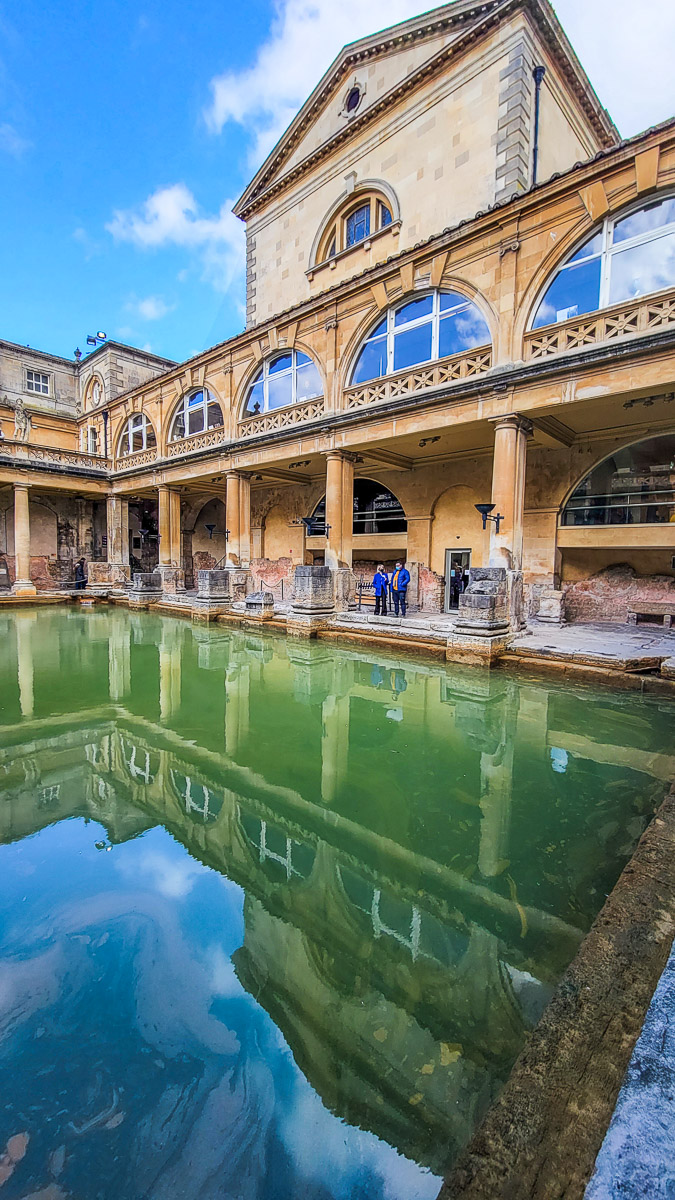
I really enjoyed the projected images of Roman characters which gave you a sense of what the room would have looked like. They also have an animated recreation of how the (thought to be) Gorgons head on the Temple Pediment would have looked in Roman times.
My favorite was learning about the curses, where people would write down on a piece of lead, a curse to those who had done them wrong and then throw it into the baths, where they believed Silus Minerva would catch it and seek revenge for them!
I loved this concept of writing out your grievances and then letting them go for karma to take care of.
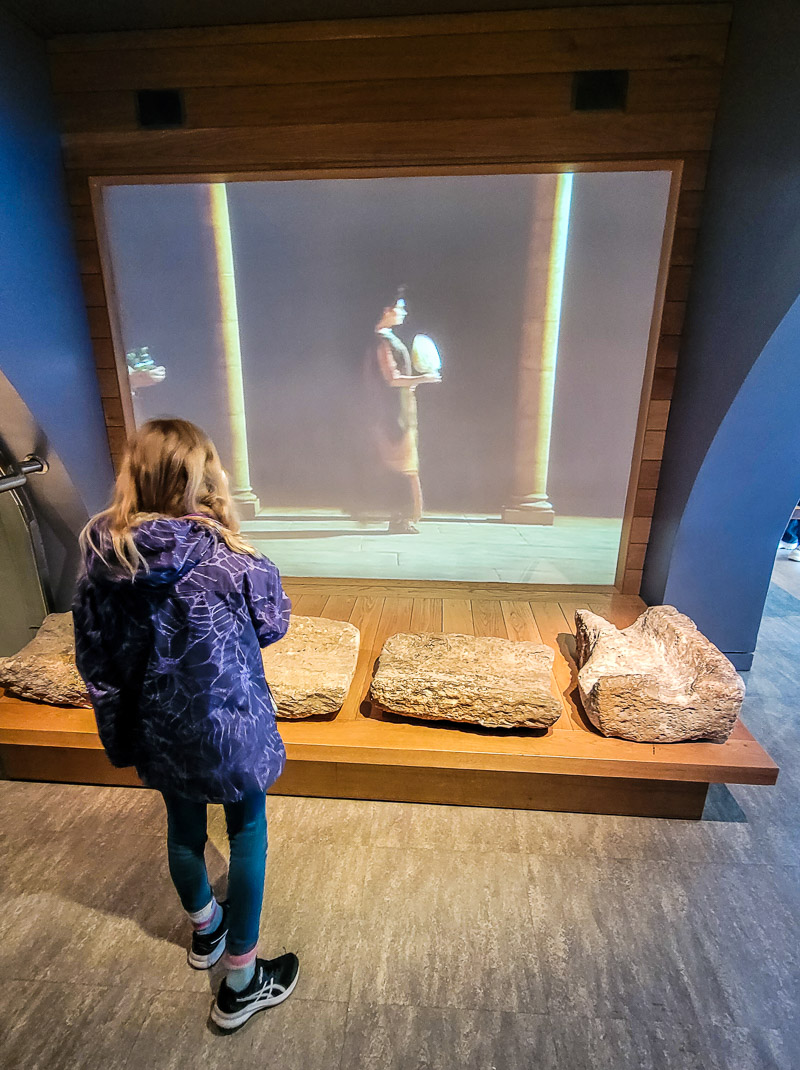

Plan for around two hours for this experience. We were fortunate to walk straight in, but typically, as it’s Baths’ top attraction, it can see crazy crowds. So, book ahead and get there early.
NOTE: You cannot swim in the Roman Baths, the waters are now poisonous (all those curses). However, the modern Thermae Bath Spa nearby has found a way to tap into the clean part of Bath’s natural thermal spa. There is an open-air rooftop pool and thermal spa with great views of the city. Plus, there are steam rooms. You must be 16 years and over to visit.
3. Admire the Bath Abbey

On the doorstep of the Roman Baths is the magnificent Bath Abbey, the last Medieval Abbey of its kind. We learned a lot about the history of this abbey on our walking tour. It was founded in the 7th century and is one of the highest buildings in Bath.
Legend has it that the Abbey was built after Bishop Oliver King had a vivid dream about angels climbing up and down ladders to heaven. In his dream, he heard a voice telling him to restore the church. And so he did.
The Abbey took many years to build and is decorated with ornate detailing and statues. You should make sure to check out the west front of the Abbey, which is adorned with more than 300 statues.
The inside is meant to be filled with magnificent stone and stained-glass windows and a fan-vaulted ceiling that is said to be one of the finest in the world
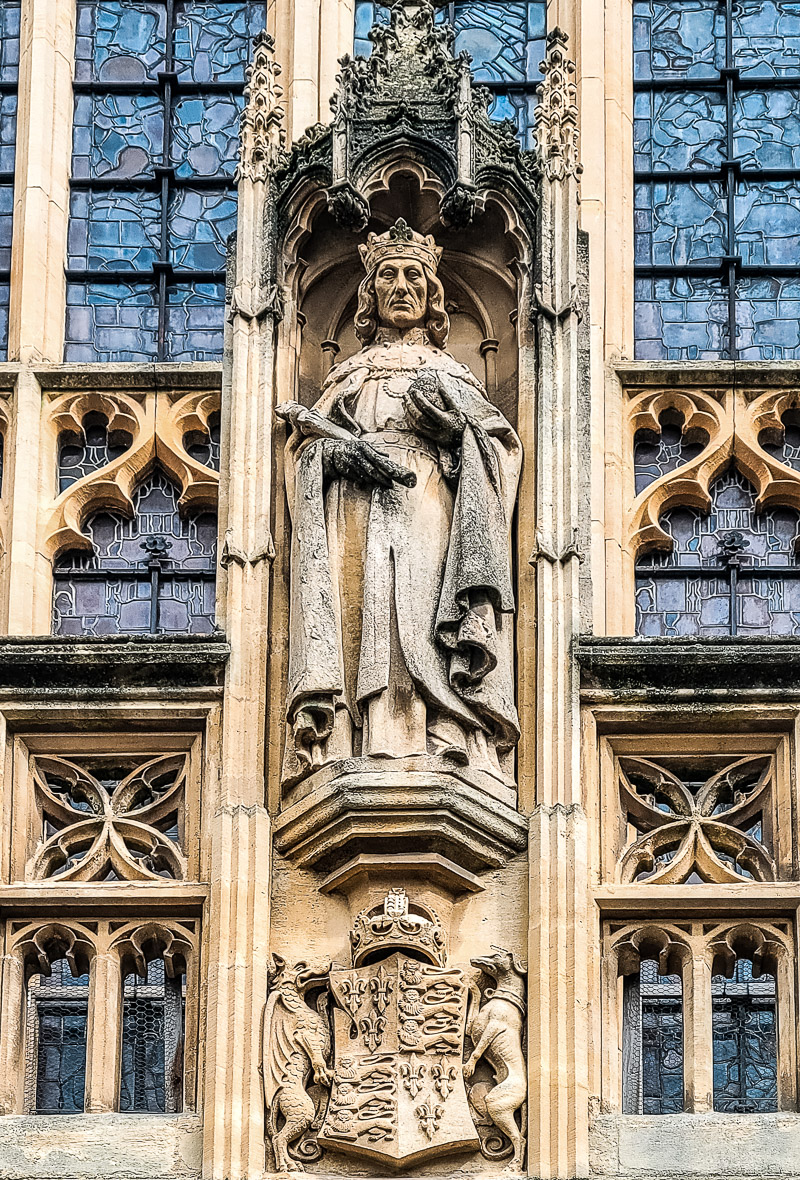
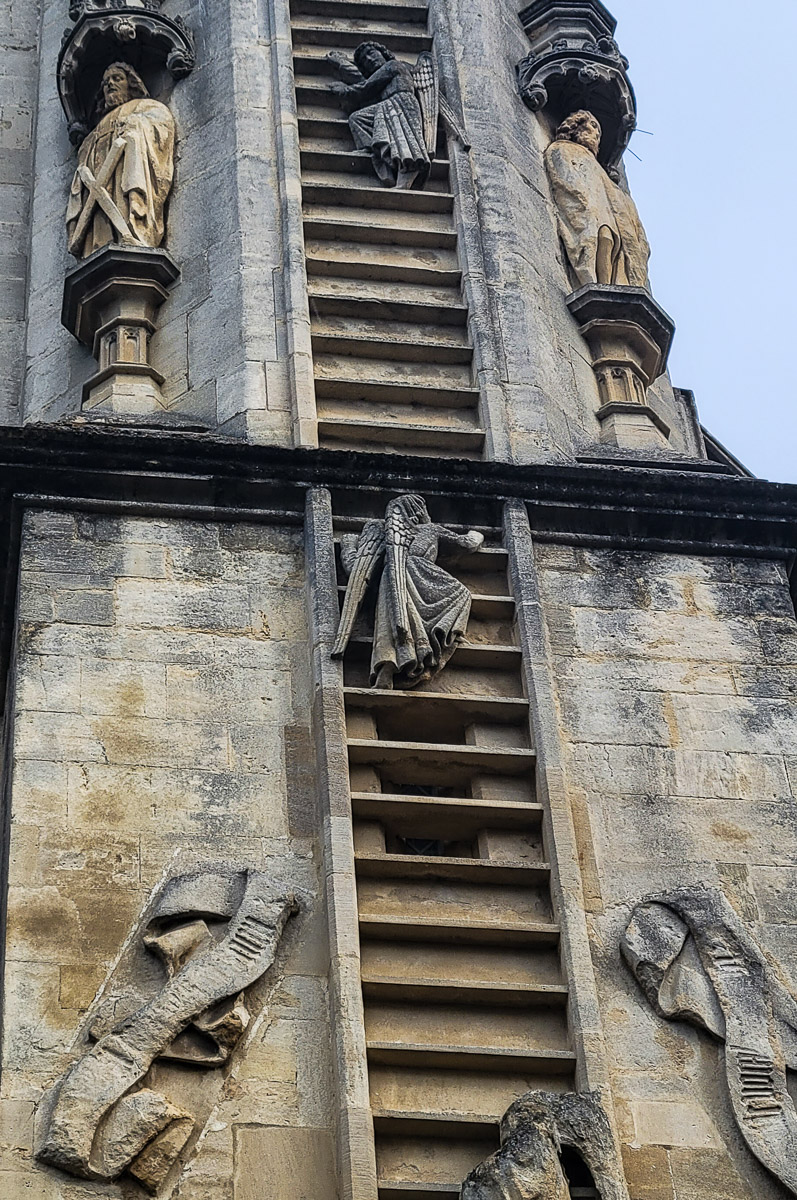
You can climb the 212 stairs of the Bath Abbey Tower for 360-degree views of Bath. We’re leaving that for our next trip to Bath.
4. Get spooked at Mary Shelley’s House of Frankenstein
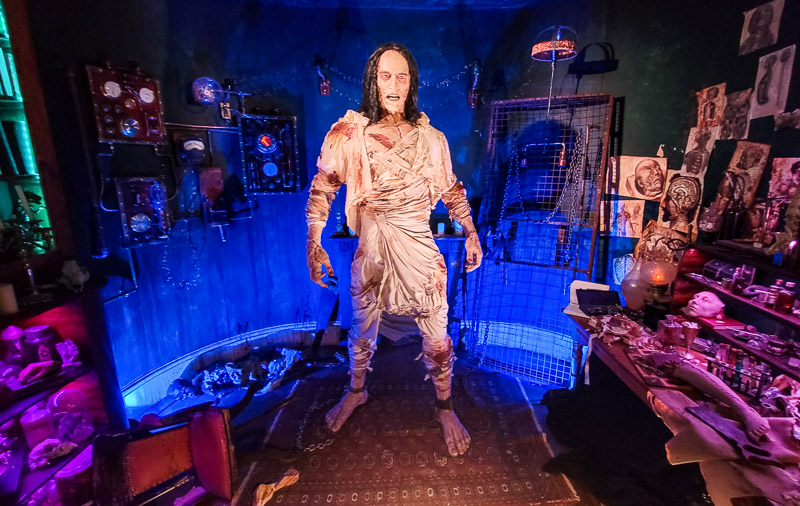
Bath is also known for its connection to the literary greats, and most people visiting Bath will dive deep into the Jane Austen story as she lived here for five years and loved it. But did you know there is another female writer in Bath who made history by creating a story that would forever change history?
Mary Shelley, author of Frankenstein, the first example of science fiction, wrote most of it while she briefly lived in Bath back in 1816 as a 19-year-old (and when she wrote Frankenstein). You can no longer see where she lived as it was torn down once it was discovered the Roman Baths were underneath. It’s now known as The Pump Room.
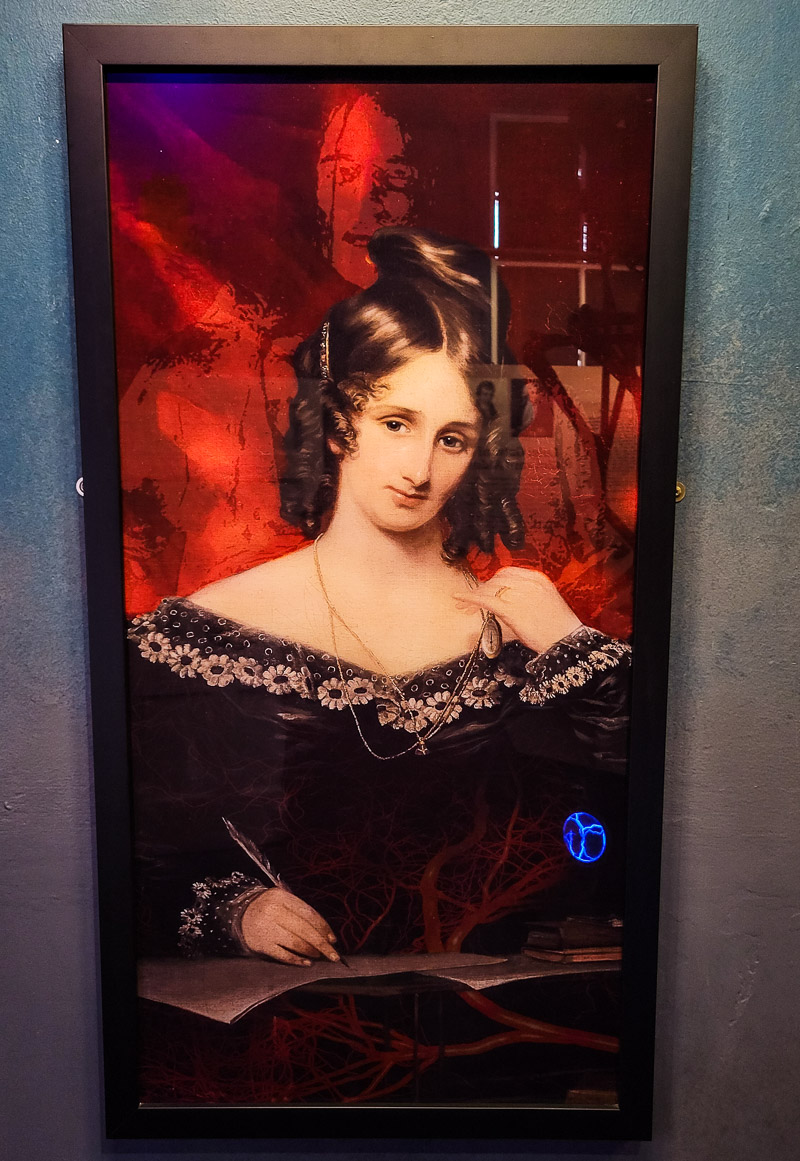
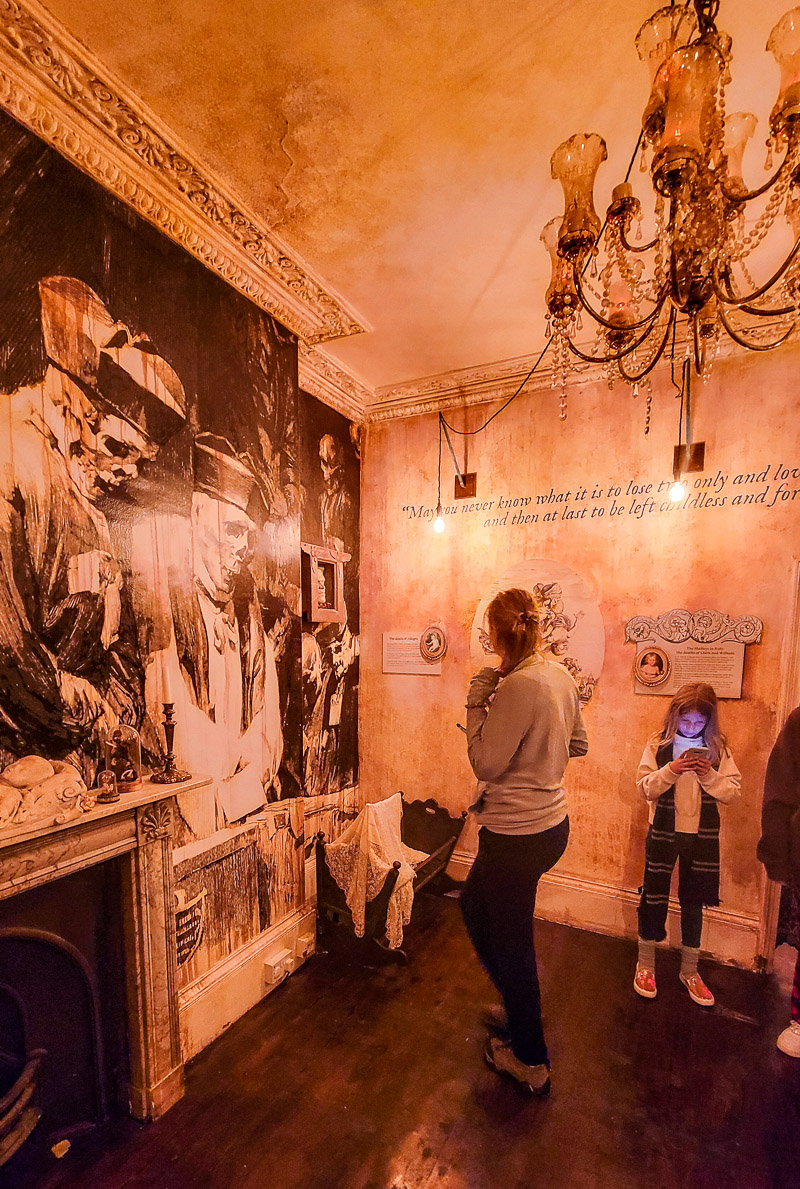
However, Mary Shelley’s House of Frankenstein pays tribute to her by telling the story of her troubled life – including her strange marriage to Percy Shelley and friendship with Lord Bryon – and what inspired and motivated her to write the book about this much-loved creature throughout the ages.
Inside this interactive museum, you’ll find four floors of historical stories, unusual artifacts, special effects, and props as well as a small cinema room showing the original 11-minute silent film. See if it scares you or makes you laugh!
What I loved was discovering what Mary Shelley’s Frankenstein REALLY would have looked like – it’s not the green creature version that we all know.
There is only about a paragraph in the book that actually describes Frankenstein, so owners took that description to an animatronics expert who then got to work creating the monster. You can see that inside the museum.
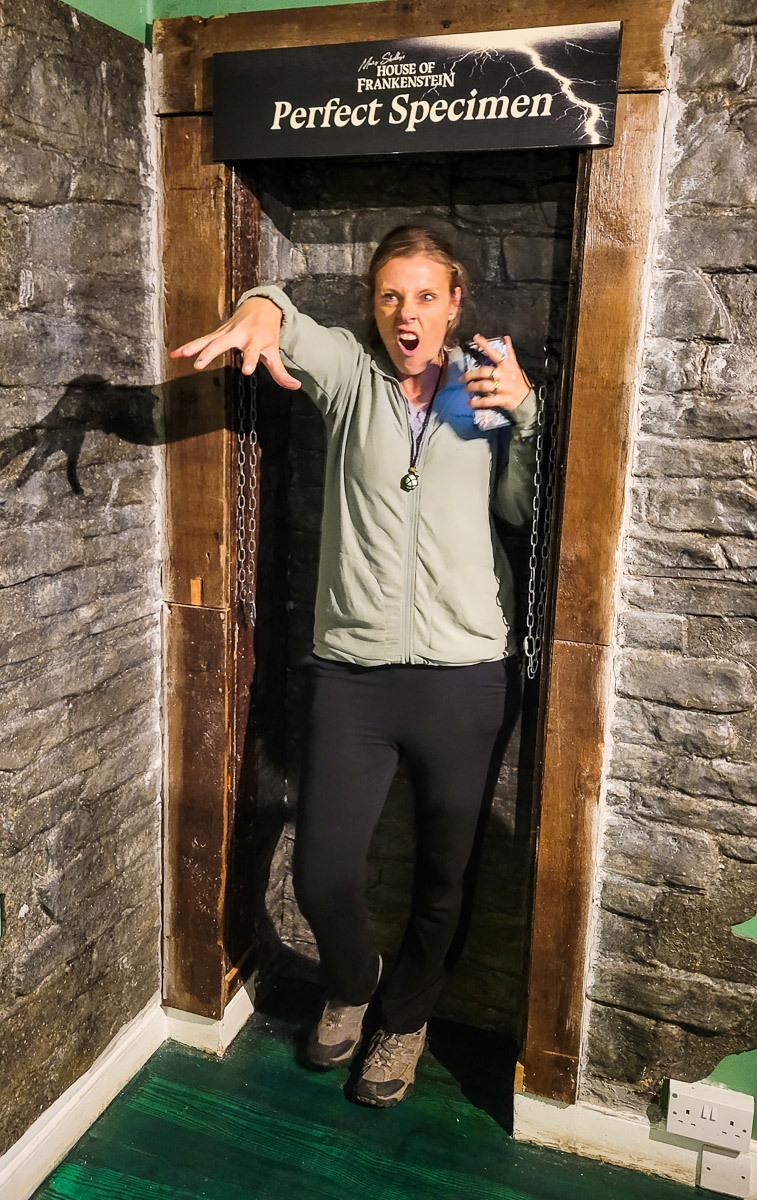

Also inside the HOF, is an Escape Room, which goes inside Victor Frankenstein’s attic laboratory. We had a brief look inside and if you love playing these games, you will love this one. You have to find the body parts to help create Frankenstein!
The thrills continue down into the basement. This fun addition to the museum is very much like tiptoeing through your favorite haunted house during Halloween. It’s filled with macabre creatures and things that shake, rattle, and jump out! Kids may find this a little frightening. Our girls raced out of there halfway through.
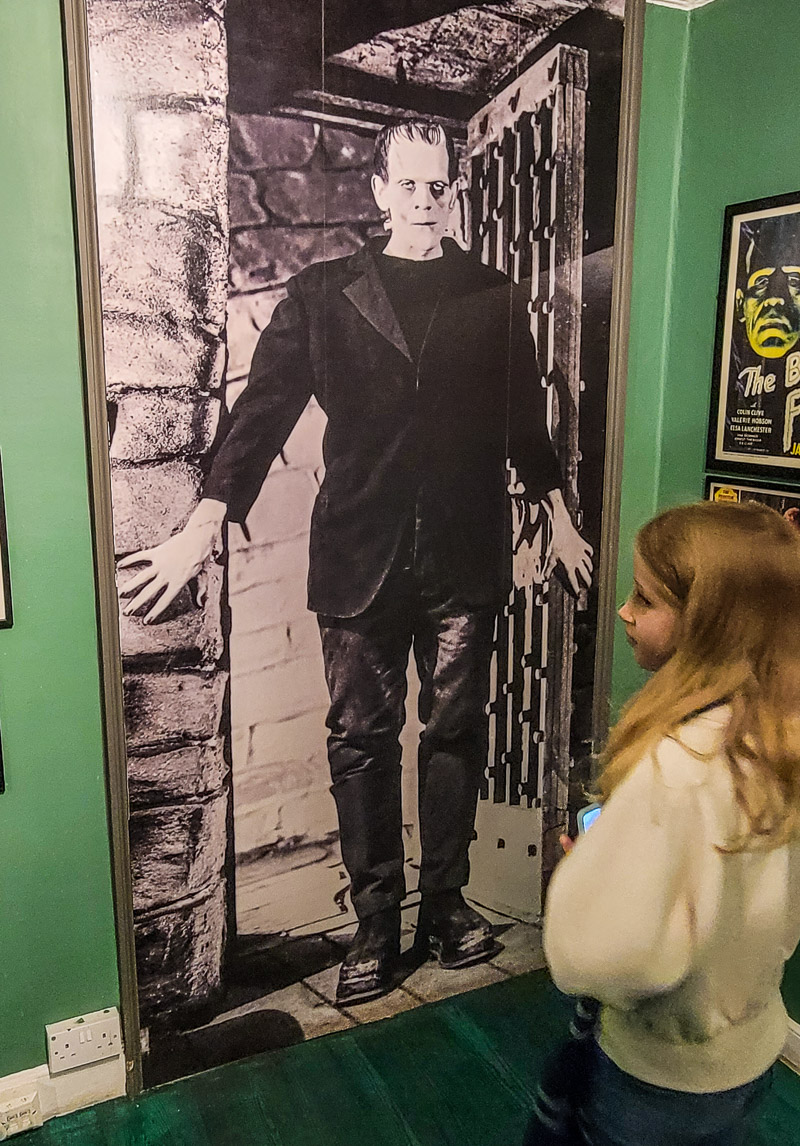
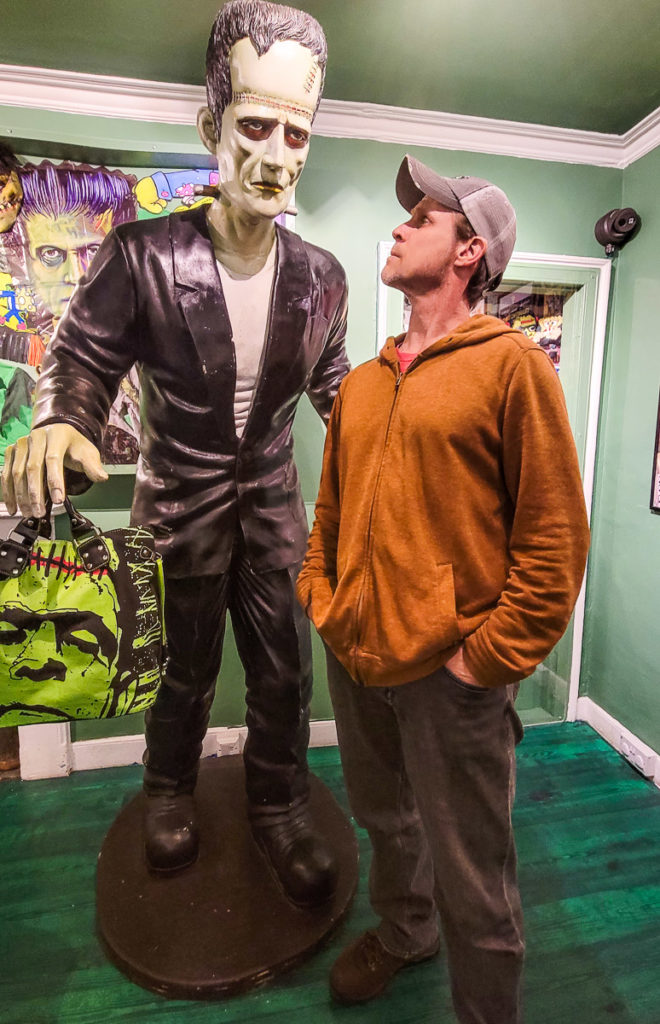
But, as soon as we left, Savannah messaged her friend to tell her the story of her visit to the House of Frankenstein and the scary basement. That’s always a sign of a memorable adventure!
5. Admire The Royal Crescent

Known to be one of the greatest examples of Georgian architecture in Britain, The Royal Crescent is an iconic scene in Bath. It’s a grand sweeping curve of 30 Grade 1 listed terraced houses, each with a view out over what once would have been rolling countryside.
On our walking tour we learned of father and son architects, John Wood Snr and John Wood Jnr who were responsible for designing much of the “newer” Bath.
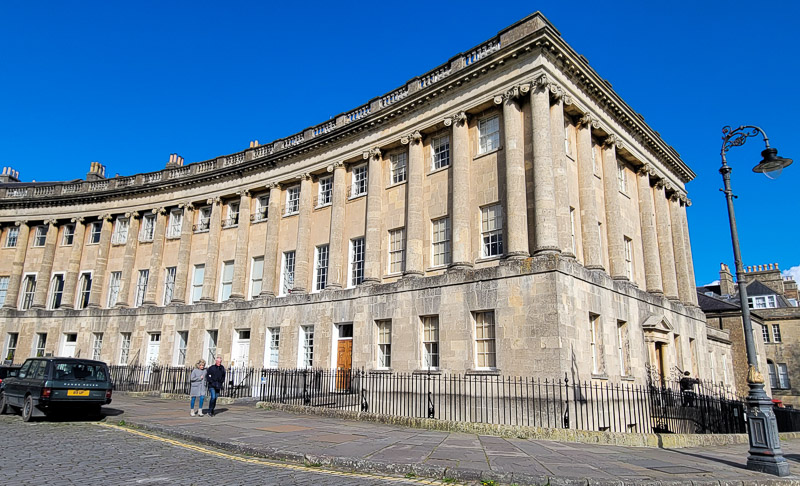
They laid out many of the city’s present-day squares and crescents within its green valley and surrounding hills, which UNESCO notes as being “the deliberate creation of a beautiful city.”
John Wood Jnr is responsible for the 150m long Royal Crescent. Built between 1767 and 1774, these homes were designed with the intention to bring the countryside into the city.
Pay attention to the ha-ha, a ditch in front of the Crescent’s private lawn. It was designed to create an invisible divide between the lower and upper lawns so as to not interrupt the view from Royal Victoria Park.
It was also made this way so the residents could look out and see cows in the lower pasture – that country feel – without them being able to walk onto the upper pasture – their private space for gathering.

No.1 Royal Crescent is the house of Lady Featherington in the Bridgerton series. It is also a historic museum where you can get a glimpse of how the wealthy lived in Georgian times. Most of the rooms are decorated and furnished just as it might have been during the period 1776-1796.
The large central house at number 16 is The Royal Crescent Hotel & Spa.
6. Marvel at The Circus
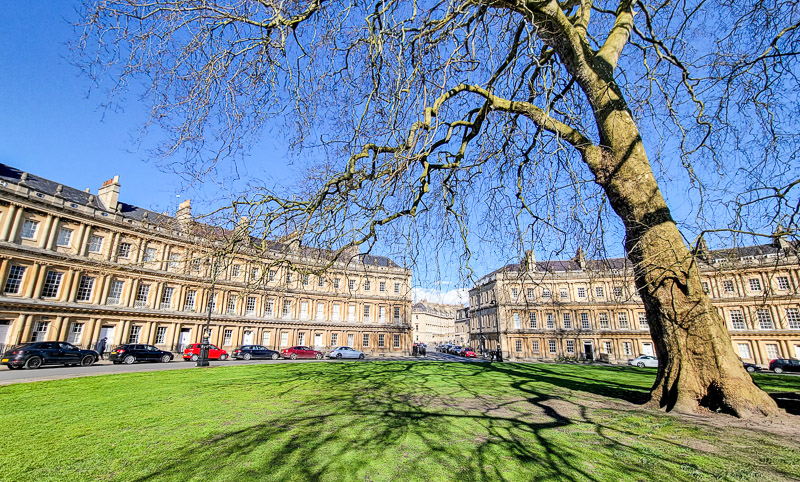
Only a five-minute walk from the Royal Crescent is the equally grand Circus, which are three curved segments of Georgian townhouses facing a public circular lawn with the most divine plane trees in its center.
It was John Wood Snr who designed and built the Circus between 1754 and 1768 and has also been designated as a Grade I listed building.
To tie into Bath’s Celtic history, Wood created The Circus to reflect Stonehenge, creating the same circular diameter of these mystical stones. Some also say the rows of stone houses reminds them of the Colosseum in Rome.

On our guided walking tour, we visited the backyard of one of these homes (No 4 Circus), which is owned by the local government to see an example of a Georgian garden. Archeologists dug it up and decided to replicate it.
It’s plain and simple with flower beds, box hedges, and topiaries and plenty of space on a paved path for walking – as was the Georgian Way.
7. Have coffee with a view on The Pulteney Bridge
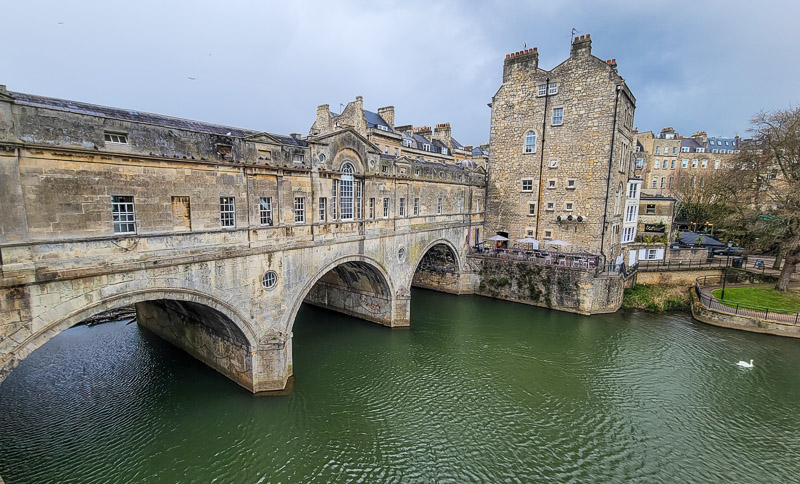
On the side of the city is the small Pulteney Bridge spanning the River Avon, built in 1774 to connect the city with the land of the Pulteney family which it wished to develop. The bridge is only one of three bridges of its kind in the world that have shops built on both sides of the bridge.

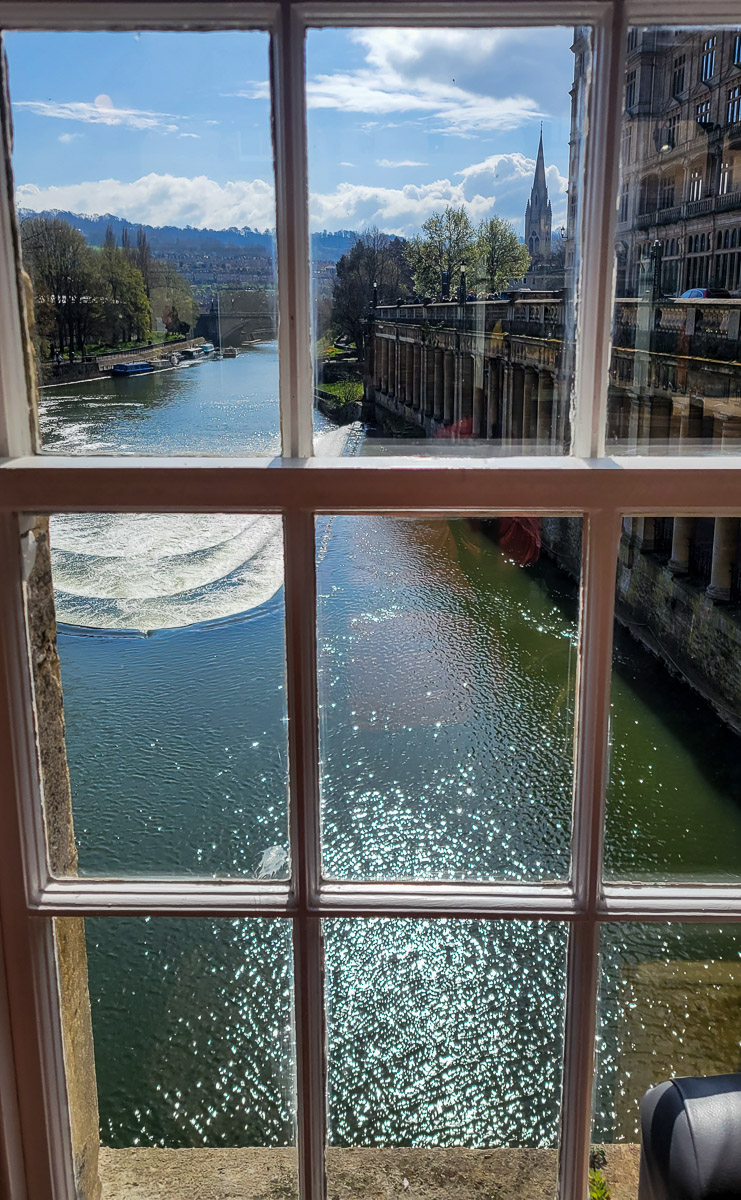
There is a small coffee shop here, the Pulteney Bridge Coffee Shop, which is a good place to rest for a while with a warm cuppa and a view of the River Avon and its weirs below. Go for a leisurely stroll along the canal after to get a great view of Pulteney Bridge from the river.
8. Visit The Holburne Museum (Lady Danbury’s House)
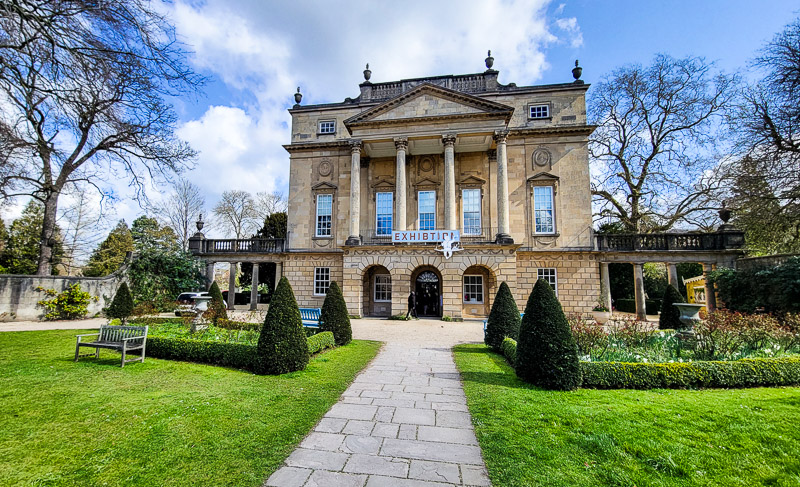
This stunning Georgian building is located within Bath’s beautiful Sydney Gardens, the only remaining eighteenth-century pleasure gardens in the country and overlook the famous Great Pulteney Street. Before becoming the museum in 1916 it was the popular Sydney Hotel.
If you’re a Bridgerton fan, this will be high on your list of things to do! The Holburne Museum is otherwise known as Lady Danbury’s House. And like Bridgerton, the Sydney Hotel used to be a place for grand parties. It was also a place Jane Austin used to enjoy visiting.

Be sure to walk around the back to see a very modern exterior with a lovely café and gorgeous gardens.
Inside the museum are exhibitions of historical and contemporary art with pieces such as renowned 18th Century portraits and Renaissance bronze sculptures.
9. See where Jane Austen lived

Jane Austen is the most famous resident of Bath, and fans may be interested in seeing where she lived in Bath from 1801 – 1806. Two of her books, Persuasion and Northanger, are set in Bath, a city she grew to love for its social status.
Walk right across the road from the Holburne Museum to see her terraced home at 4 Sydney Place.
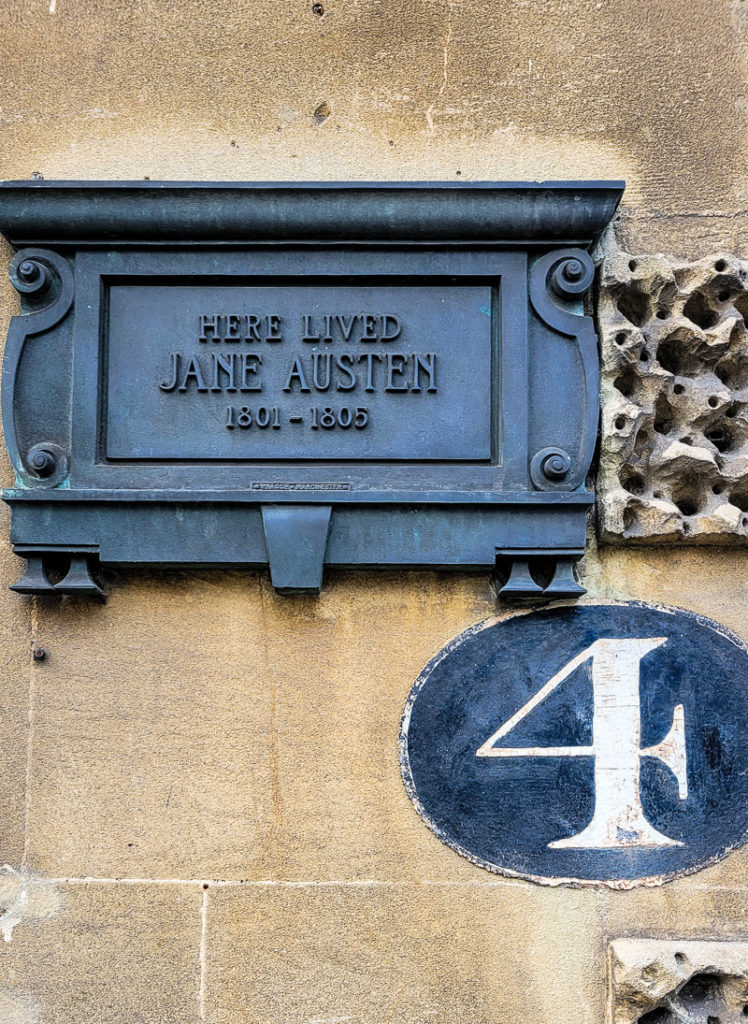
We did not get a chance to visit the Jane Austen Center, as we’re not a big enough Jane Austen fan to commit to a museum, but fans say it’s a really well curated museum.
The center gives a snapshot of her life during Regency times and how it affected her writing (it’s right next door to House of Frankenstein, to help with your itinerary planning).
10. Walk along the River Avon and the canals

Bath is surrounded by beautiful waterways, including the historic Kennet and Avon canal, and the iconic River Avon. It’s the perfect place for an afternoon stroll, or even a boat tour, or punting experience.
We loved that our accommodation was just a 15-minute walk into town along the picturesque Kennet and Avon canal paths.
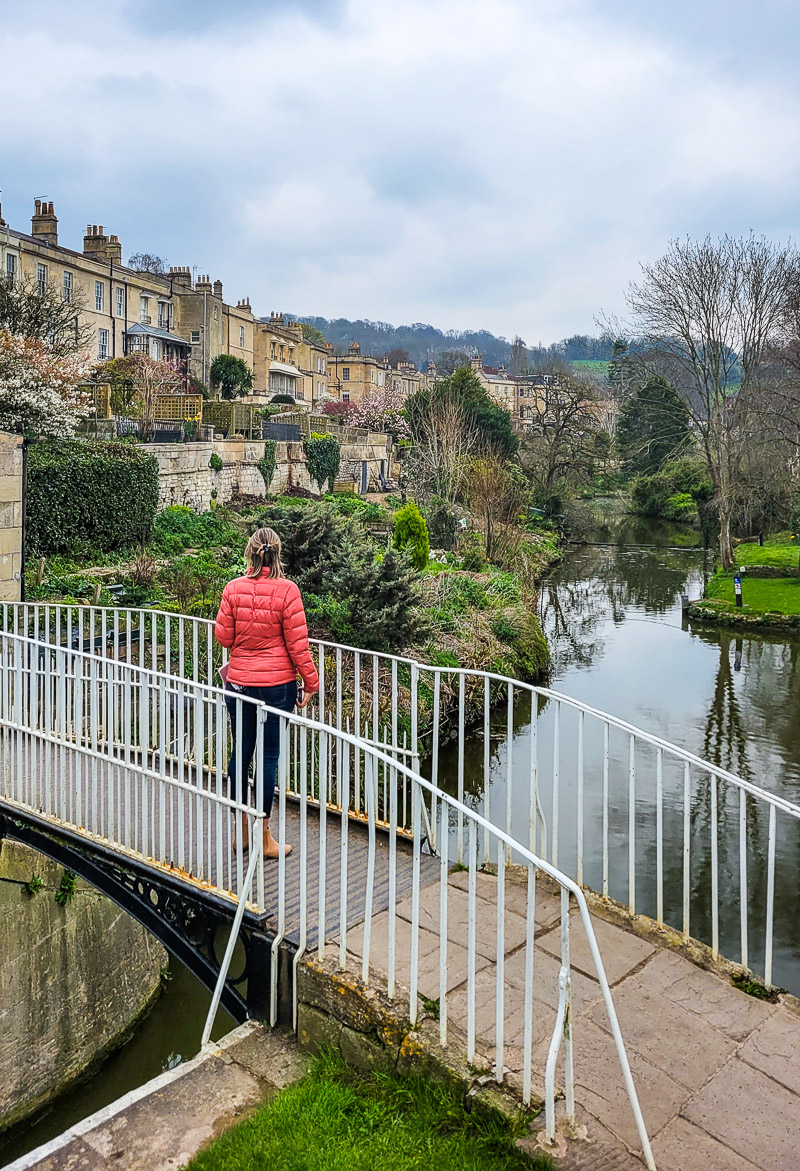

11. Eat a bun at Sally Lunn’s Historic Eating House and Museum
No trip to Bath is complete without tasting a famous Sally Lunn Bun, a unique sweet, brioche-style bread which originates from Bath, and was named after a 17th-century Huguenot refugee, Solange Luyon, who brought the recipe to the city.
We were so happy to run into Sally Lunn’s Historic eating House after a freezing, and snowy, Bath guided walking tour. There is no better way to warm up than with a Bailey’s coffee and a Lunn bun.

Sally Lunn’s is known to be the oldest house in Bath, dating back to the 1600s. You’ll notice its age immediately upon entering and crouching down due to the low ceilings, narrow creaking staircase, and small rooms.
The kitchen museum shows the actual kitchen used by the legendary young Huguenot baker Sally Lunn in Georgian Bath to create the first Bath Bunn, a light, flaky treat that’s part bread, part cake and topped with savory or sweet toppings.
It has a rich, eggy, and creamy dough, and are traditionally eaten with butter or jam, but of course in 2025 there are more extravagant flavors to choose from.
The decision now is will you choose sweet or savory? Craig and the girls decided on sweets with a cinnamon butter topping and chocolate butter for Savannah.


As I am gluten free, I was thrilled to see they had delicious gluten free scones with jam for me. They were probably the best I’ve ever had.
NOTE: After leaving Bath, I heard of the rival Bath Bun, which you can find in different areas of Bath. It’s smaller than the Sally Lunn Bun and contains fruit and a sugar lump and is topped with currants and sugar crystals. Taste both and let me know in the comments, which was the clear Bun winner?
12. Visit the Jane Austen Centre
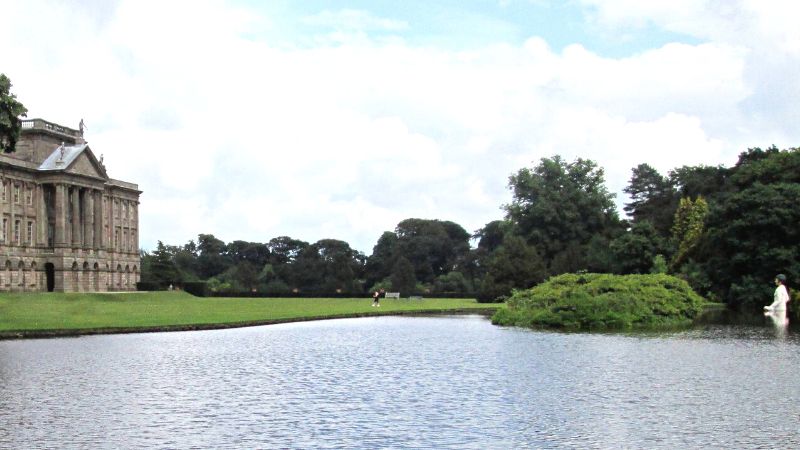
As mentioned earlier, if you want to learn more about Jane Austen and her novels, then you should make sure to check out the Jane Austen Centre.
The museum tells the story of her life and work, as well as gives a historical background to the Regency period that she lived in. What’s unique about this museum is that the story is told by actors dressed in Regency costumes, bringing you closer to her life in a more immersive way.
The museum also runs the Jane Austen walking tours, which take you past places that either featured or inspired her work.
13. Roam around Prior Park Landscape Garden

Prior Park Landscape Garden is a National Trust property in Bath showcasing a lovingly restored 18th century manicured garden. The garden features historic bridges and dams, as well as a river. The gardens were designed by the English 18th century poet, Alexander Pope, and landscape gardener, Capability Brown.
This is a lovely, quiet place to relax and see some authentic 18th century gardens. The garden’s iconic feature is the Palladian bridge, which sits in the center of the park.
14. Learn about William Herschel at the Herschel Museum of Astronomy

William Herschel was a famous astronomer and musician born in Germany who lived in Bath. He used to live in a townhouse on New King Street, which has now been turned into a museum dedicated to him.
William Herschels lived in this house from 1777 – 1784 with his sister, Caroline, and is most famous for discovering Uranus using a small, 7-inch telescope which he built himself in his workshop.
The museum has been operating since 1981, and contains original possessions that belonged to Hershel, including his dining table and the workshop where he made his famous telescope.
You can take an audio tour of the house, as well as visit The Caroline Lucretia Gallery, which is an extension of the house.
15. Visit the Bath Christmas Market (Seasonal)

Christmas is the most magical time of the year and in Bath, they go big for Christmas. The Bath Christmas Market has become legendary in the UK, having sustainable pop-up chalets selling artisan gifts and food, and spreading Christmas cheer to everyone who comes here.
The market is open from the 24th November until the 11th December, so it’s a great place to get into the festive spirit and shop for unique gifts to give on the big day.
There are more than 150 chalets at the market, and you can also see dance troupes, choirs, musicians and performances by local schools in the evenings.
The market is spread all over the city, but you’ll find most chalets near popular sites such as the Bath Abbey, Roman Baths, and Thermae Spa.
If you’re not visiting during the Christmas holidays, be sure to check out what other festivals are happening in Bath. There is always something going on! In fact, the Bath Festival which takes place in May is a 9-day event celebrating music and books!
16. Have afternoon tea at The Regency tea rooms

Afternoon tea is the most quintessentially British thing you can do, and why not have a high tea experience in the most quintessentially English city in the country?
The Regency is an elegant, regency-inspired tearoom, which is located inside the Jane Austen Center, and is known for having a wonderful traditional afternoon tea.
Surround yourself with elegant decor, and Jane Austen charm, whilst enjoying English breakfast tea, scones, mini sandwiches and cakes. Note that although it’s part of the Jane Austen Center, it’s not included in the entry ticket and is a separate attraction.
17. Take a day trip to Stonehenge and the Cotswolds

Although Bath itself has tons to do, it’s only an hour’s drive from the UK’s most iconic historic landmark, Stonehenge. This mistical stone monolith circle has mystified and intrigued humanity for centuries. It’s estimated to be around 4,500 years old, and what’s unique about it is the stone is not from this region – so how did they get there? Is it a celestial calendar? A sacred burial site? A prehistoric party venue? The jury’s still out on that one.
After admiring these monoliths overlooking the Salisbury Plain, why not drive over to the Cotswolds villages? This quaint region in the UK is known for its rolling hills, storybook cottages, and woolly sheep. Visit villages like Bourton-on-the-Water or Stow-on-the-Wold, which are known for their honey-stone cottages that look like a fairytale setting.
Wander their quiet lanes, duck into cozy pubs, or ramble along countryside trails, before heading back to Bath.
18. Have some of the best coffee in Bath at Colonna & Small’s

We’re always on the hunt for good coffee. When I read that Colonna & Small’s is known to have some of the best coffee in the country, I led us straight there. This bespoke coffee shop that gives love and attention to the craft, will serve you a delicious creamy cup of coffee in any style you like.
19. Take a day trip to the Jurassic Coast

In the summer months, why not drive down to the Jurassic Coast for a day on the beach. The Southwest has some of the best beaches in the UK, and just below Bath is the Dorset National Landscape, which is also connected to the UK’s Jurassic Coast.
The Jurassic Coast is so-named because it was once connected to Europe in Jurassic times, and still to this day, dinosaur fossils wash up on its shores. If you’re into fossil hunting, the best places to go for that are Lyme Regis and Charmouth. The best time for fossil hunting is in the winter, after a storm, as the weather washes the fossils up.
Otherwise, if you just want to laze on a beach, Durdle Door is a must-see, known for its chalk white sea stack, which you may recognize from productions such as Nanny McPhee and The Chronicles of Narnia: The Lion, the Witch, and the Wardrobe.
Lulworth Cove is also a breathtakingly beautiful beach surrounded by cliffs of limestone and chalk. Read our itinerary guide for a Devon to Dorset road trip.
Places to eat in Bath (and Drink)
Bath has a vast array of places to eat and drink to suit any kind of preference. When we visit England, we love to eat at pubs, as it’s such a homely experience with fascinating history, and good food and ales. Our focus wasn’t on food for this trip, more just grab and go to fill the belly in between attractions. I’m sure foodies will love the Bath food scene. Here are the places we ate at and enjoyed.
Breakfast


Boston Tea Party: Not only will you find healthy, delicious British food here that uses quality ingredients, it’s also a business that cares about sustainability. We enjoyed a relaxed breakfast here. Either go for the traditional Big Boss English breakfast, or the more modern Sweetcorn Hash, and our kids enjoyed pancakes with bacon. There is an outside seating area on the edge of a busy Bath square perfect for people watching.
Diana’s Cafe: Across the road from the train station, we found a great breakfast spot before catching our train to Oxford. All organic, good coffee, good English breakfast, and hot chocolates.


Lunch
Bill’s Restaurant: A great spot for an intimate sit down lunch with table service. Bill’s uses seasonal ingredients with an ever-changing menu. They have plenty of options for dietary requirements and kids. Craig enjoyed his burger, and my Butternut Squash and Spinach lasagna.


The Boater: We stopped in for lunch here with our friend Laurence who lives just outside of Bath. Boater is located next to Pulteney Bridge, so expect river views and a spacious beer garden. We enjoyed the window views of the SNOWY landscape from the warm interior. You’ll find typical pub faves such as fish and chips. I was satisfied with one of my favorite English meals – chips with mayo (that is fries for the Americans).

Dinner
The Curfew: Our accommodation recommended The Curfew as their favorite place to eat in Bath. Sadly, the kitchen was closed due to the chef having COVID. But, we did stop for a drink. I was thrilled they had gluten free beer. It has a cozy, sophisticated Georgian vibe with a wood paneled bar, beamed ceilings, high windows, nooks, and crannies to sit in.

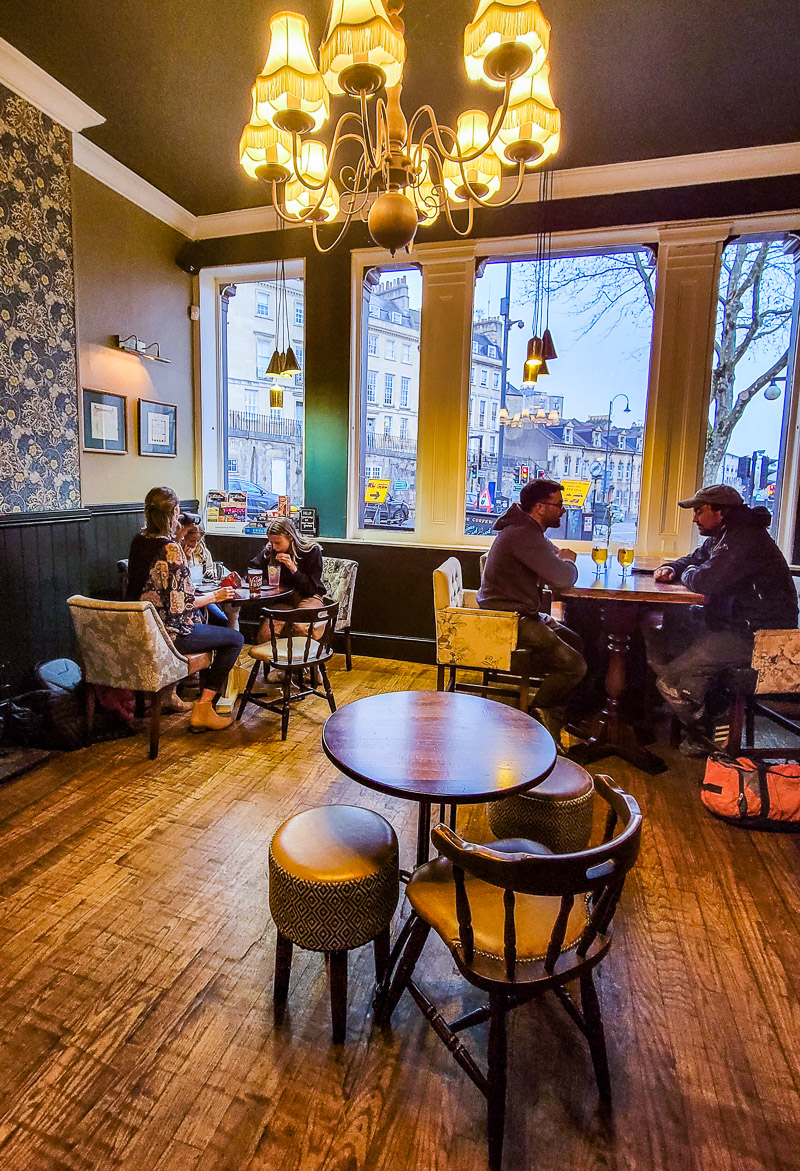
Slug and Lettuce: Known to the locals as a cheap student pub, it’s a decent place to eat if you’re on a budget. Here you’ll find that modern floral color style with Bridgerton vibes. They have a kids’ menu that includes a drink and dessert. Be sure to eat before 8pm, as kids aren’t allowed after that time when it becomes the place for young’uns to party! There’s a great menu for adults too with a huge variety. I loved my butternut squash tagine.
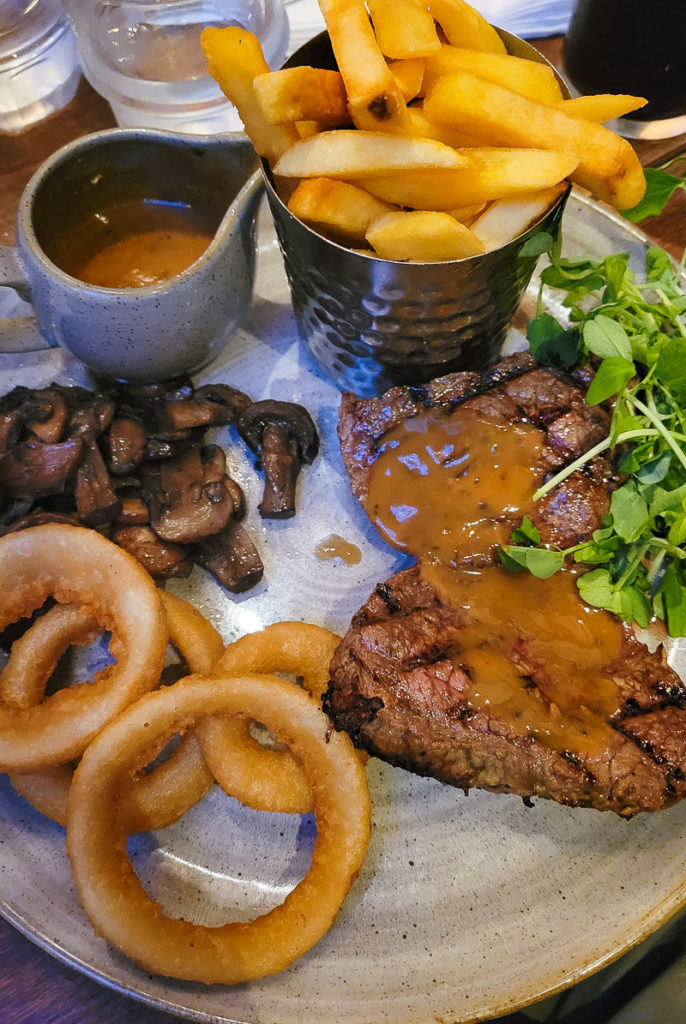
The Pulteney Arms: While most pubs are kid-friendly, we were glad the girls stayed in the house when we popped in here for a drink and some takeout. It was packed with local rugby players – well we assume that, as it is known as a rugby pub. Bath Rugby Club is one of the oldest in existence in the UK. It was small and cozy with a great neighborhood vibe.
Getting to Bath from London

The best way to get to Bath from London is by train. It’s about 80-minutes direct from London Paddington Station. We booked our train tickets via TrainLine on a Great Western Railway service. We also caught a direct train from Bath to Oxford, which is an option if you are coming from that direction. That was just over an hour but did include one stop and change.
The Bath Spa train station is located in the heart of the city center. From there we walked 15-minutes in either direction to our accommodation and related sites. There are places across from the station where you can store your luggage if you arrive too early for check-in (which is very useful as you don’t want to drag your luggage around the cobblestone streets of Bath all day).
A car is not needed or recommended to get to Bath, unless you plan on taking day trips, then it will be much cheaper and easier to hire a car at the airport in London and drive.

One of the things you’ll love about Bath is the noticeable absence of cars. In an effort to reduce high levels of pollution the city of Bath has created a Clean Air Zone. You will be charged a fee if driving a higher-emission vehicle in the zone. Bravo. That means cleaner air and fewer cars within the city center making it feel almost like a pedestrian-only city.
Plus, car rental in the UK is expensive, fuel prices are high, and cars tend to be smaller (to fit on smaller village roads), which can pose a problem if you are traveling in a group with a lot of luggage.
If you are on a UK road trip and are driving, there are Park and Ride services in Bath, offering buses into the city. That way you avoid the tax and try to park in the city center.
National Express is also an option if you want to catch the bus, which is much cheaper than a train but it takes a lot longer. If you insist on renting a car, check rates here with DiscoverCars.com. If renting a car from Central London, you will have to pay a Congestion surcharge per day you are in the zone, so it’s best to hire from the airport.
Where to stay in Bath
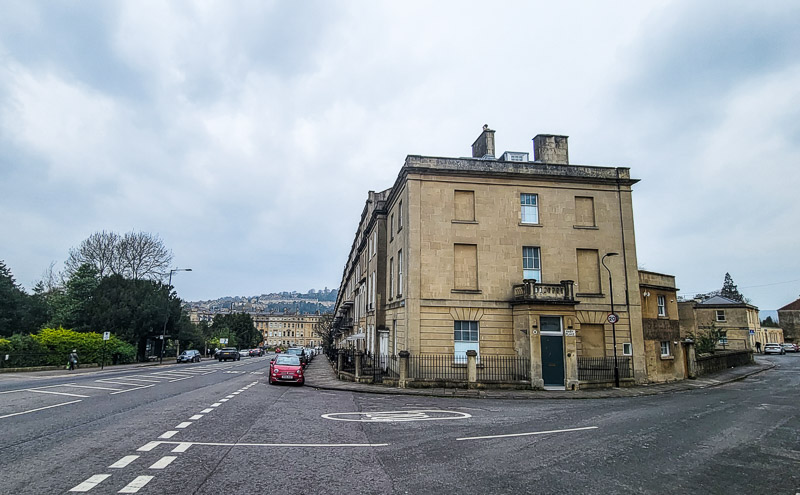
In a city like Bath, part of the experience is staying in accommodation that reflects the unique beauty of Georgian architecture. While you could stay at one of the luxury hotels in Bath, a Georgian townhouse is much more authentic.
We stayed as guests at the Steam House, a luxury Georgian townhouse that has a chic modern style reflecting a Bridgerton flair. Just like every scene in the Netflix series, this house pops with colors from the featured floral wallpaper to the photo booths draped with flowers, the vibrant colored couches and furnishings, and the little features like framed letters from Lady Whistledown.
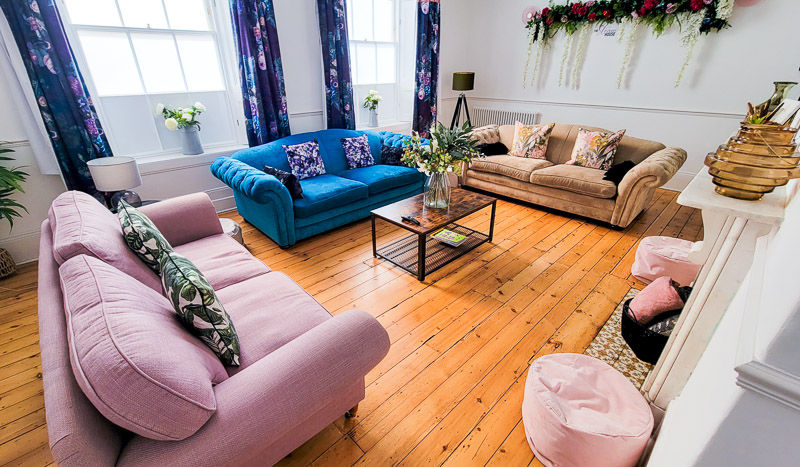
There are five floors, and six bedrooms that can sleep up to 25 people. The bedrooms have king size beds that can be unzipped to single beds. There are also extra single beds and a few sets of full sized bunk beds for extra guests.
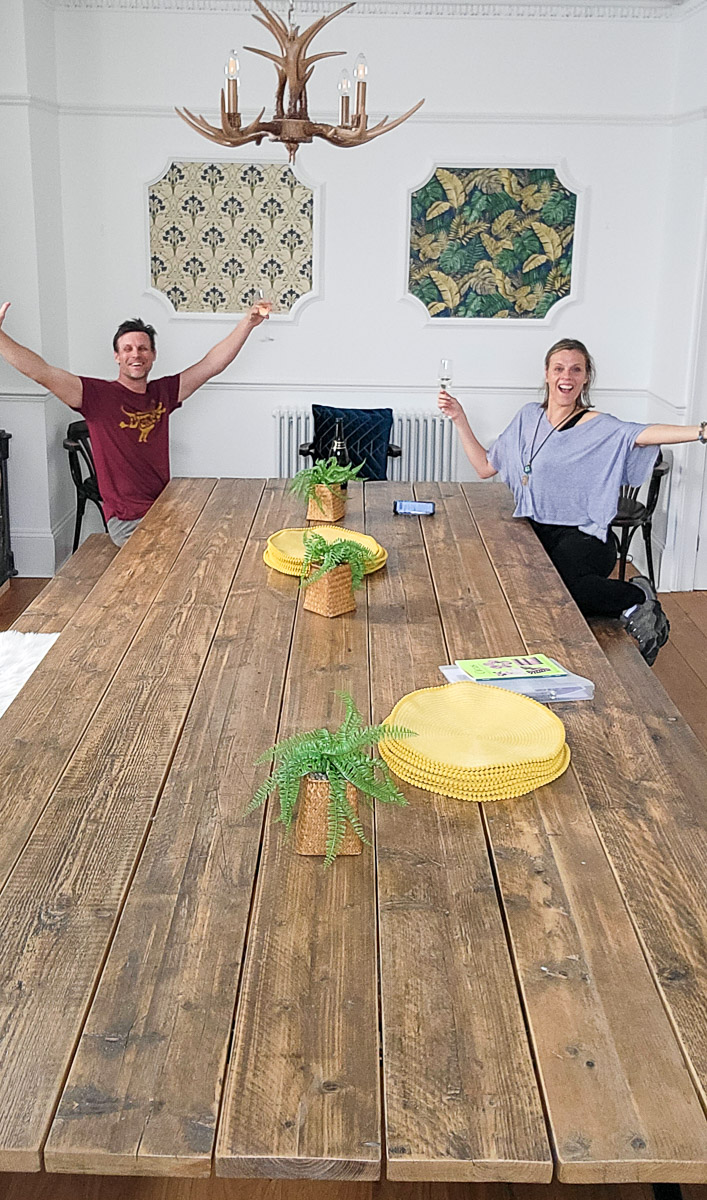

Each room has its own dry bath with comfy pink stools in front of gigantic mirrors with hairdryers AND hair straighteners. You’ll also have a bath tub near the window in the main room and one in the main bathroom.

We appreciated the laundry room to catch up on laundry after a week in London!

The townhouse is huge and perfect for large groups of families and people traveling together. It actually makes it an affordable and glamorous accommodation choice.


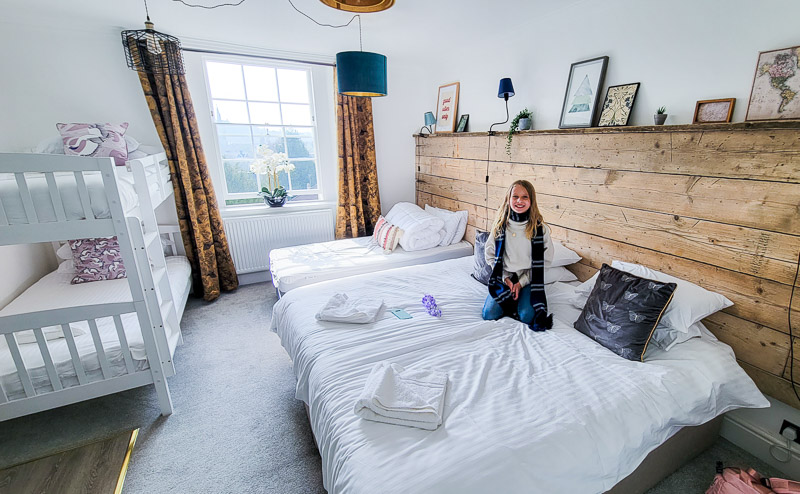
The house was an easy 15-minute walk into Bath city center and was across the road from a small Tesco, and a couple of other small independent stores, and around the corner from Lady Danbury’s house and a cool neighborhood rugby pub!


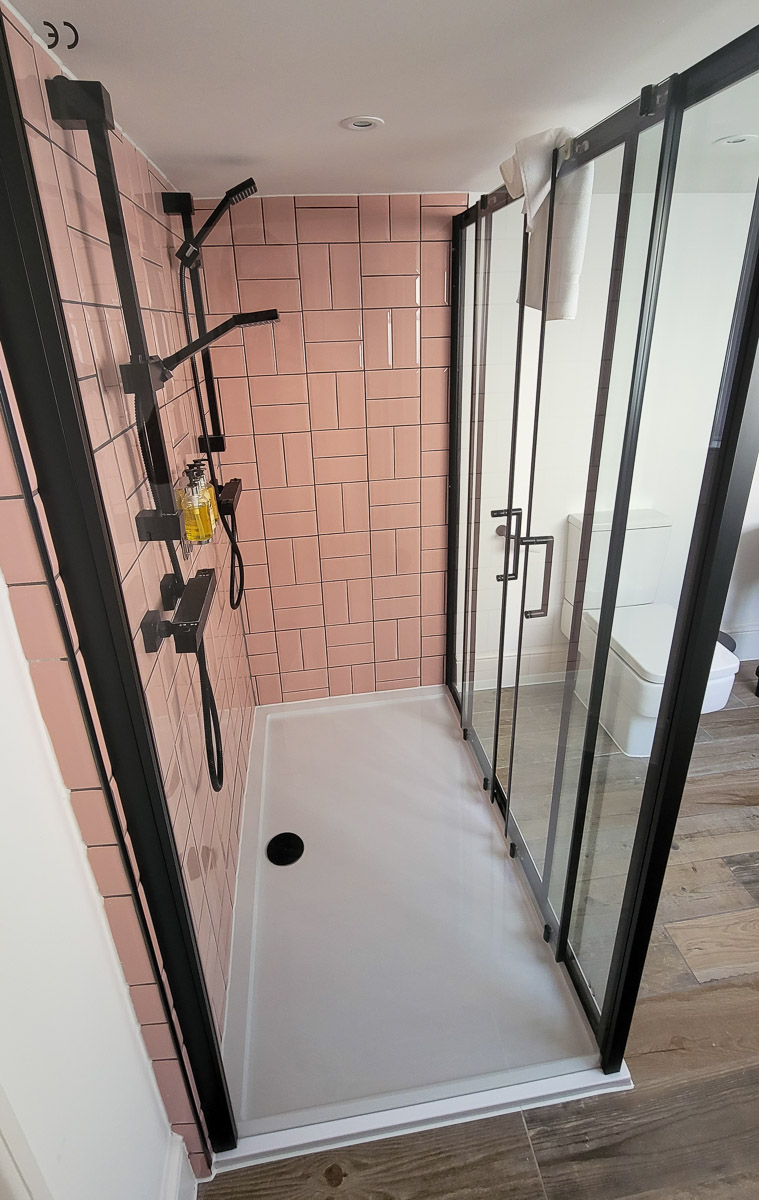
It’s best to book Bath accommodation that lies within or near to the city. Bath is a very walkable city, and a car is not needed. Unfortunately, the house we stayed in is no longer available, but you may find another at Bath Luxury Rentals, or you may like the following places to stay in Bath.
Final thoughts

Bath is the only entire city in the UK that’s designated as a UNESCO World Heritage Site. It’s a grandeur you can’t deny as you walk its beautiful streets lined with stunning Georgian Architecture made from local golden-colored Bath limestone.
Over the past couple of years, Bath has been put back on top of people’s list of places to visit in England thanks to the Netflix hit, Bridgerton, which was filmed extensively in Bath – the perfect backdrop for the glamor and romance of Regency London. When released in Christmas 2020, it quickly became the network’s biggest show to have aired.
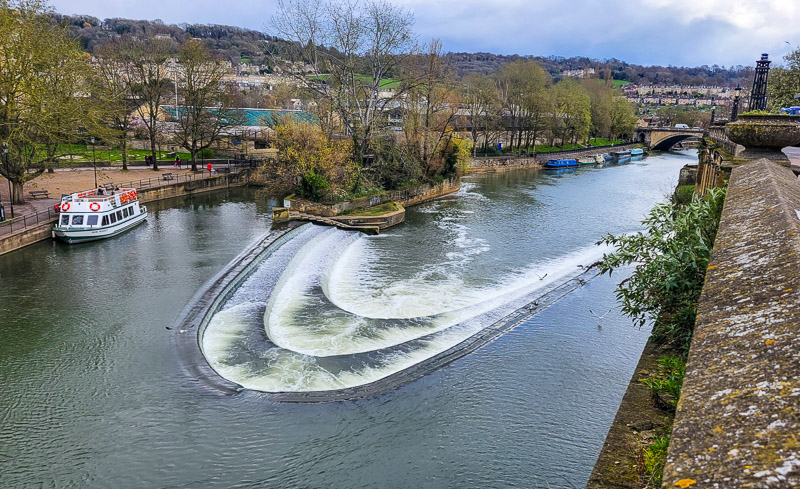
Bath is every bit as beautiful as it appears on the Bridgerton screen. One thing I loved about Bath is the ease of getting around this city. It’s very walkable and most streets inside the historical part of the city are pedestrian streets or see very little car traffic.
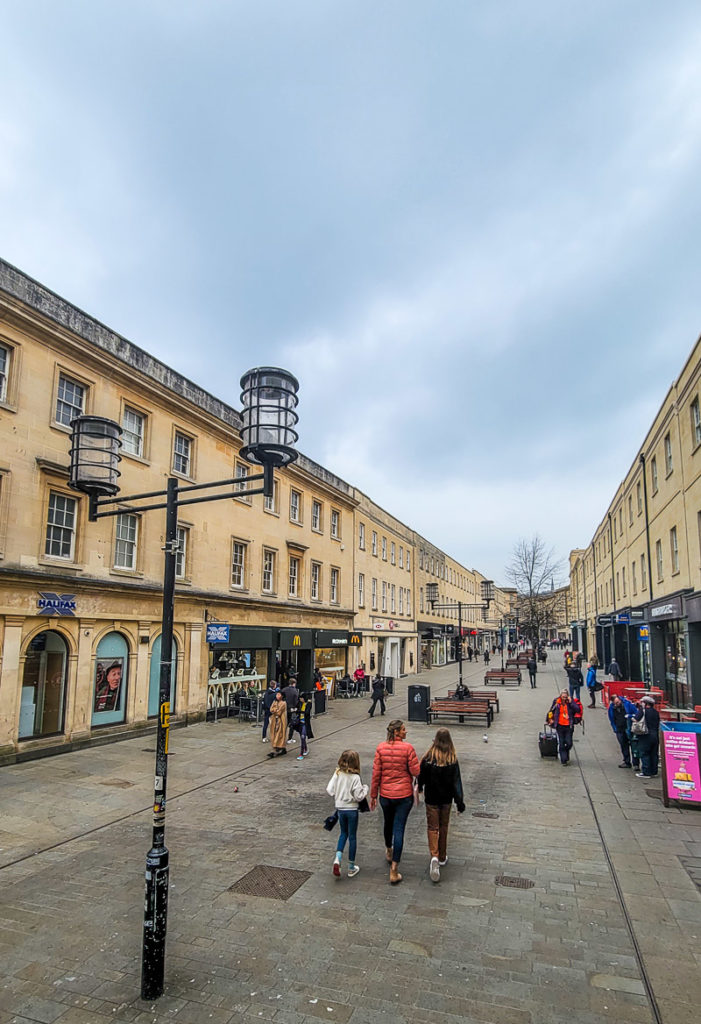
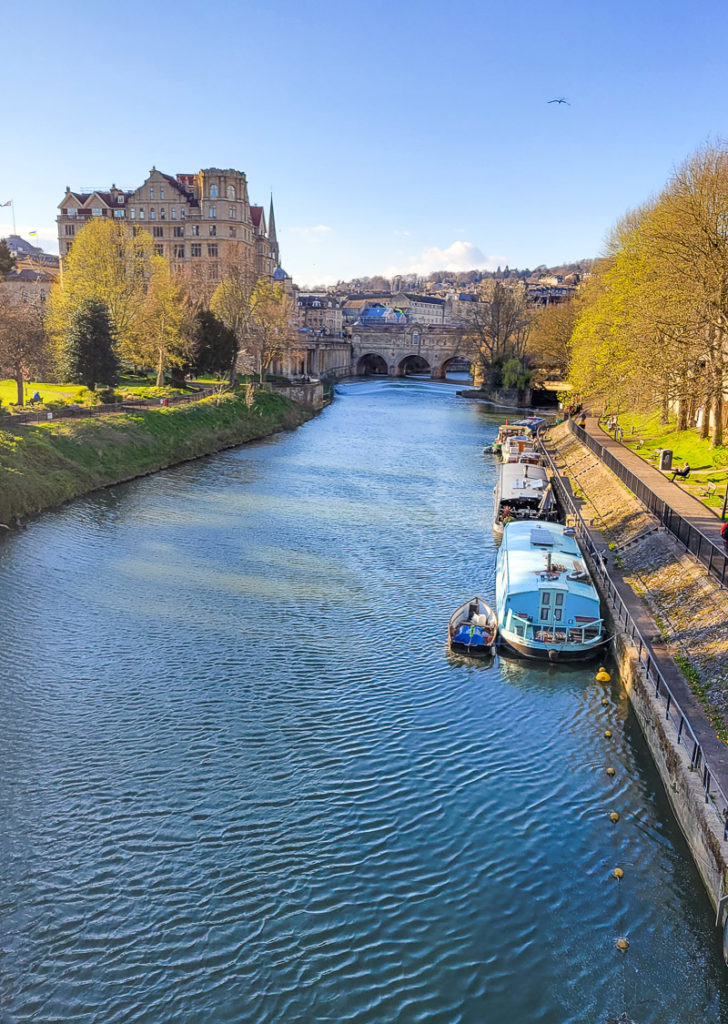
More UK Travel Tips
If you’re visiting Bath on a day trip from London, then you might enjoy reading these other guides on places to visit in London.
Pin To Save It On Pinterest


We have fond memories of our visit to Bath, and look forward to returning for more. Leave a comment below if you have any questions about Bath!

